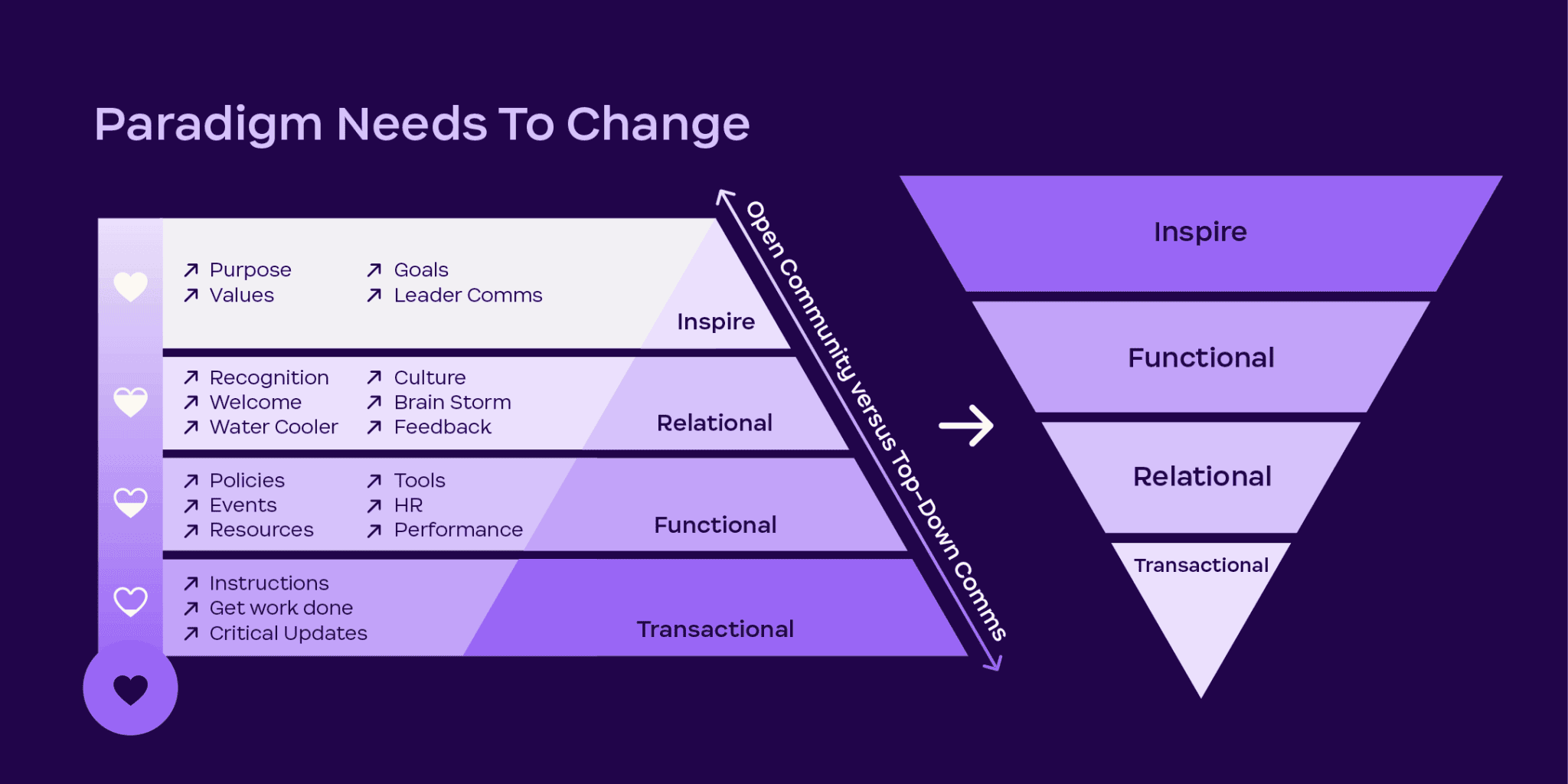Transactional vs Inspirational Comms: Striking the Balance

Colum Nugent
Head of Expert Services at Workvivo
October 1 2023

There’s no time like the present to educate yourself on the crucial distinction between transactional and inspirational comms.
Wondering why your company communications are falling flat? When you put time, energy, and money into an internal newsletter or launch a new workplace tool like Workvivo, it can feel anti-climactic when there’s markedly low buy-in from your teams and a tumbleweed rolls across your desk.
One of the top causes of low engagement is favoring transactional communication over inspirational or relational communication. If every time you speak to your employees it’s to talk about things like productivity and earnings, rather than to encourage colleague camaraderie or peer-to-peer recognition, then it isn’t hard to see why people aren’t so interested in listening – let alone talking back.
Carving out the time to invest in those relational messages can be daunting. You might be thinking…
“Our CEO is so busy. It’ll be hard to get her to post on Workvivo”.
“Our leaders are very busy people. It’s not realistic to expect them to be active on Workvivo.”
“Won’t asking our leaders to post updates add more work to their already busy schedules?”
“How does Workvivo facilitate people getting work done?”
What these lines of thought tell me is this: lots of people prioritize transactional comms over every other type of communication in the workplace, and those people are missing the point of an employee experience platform like Workvivo – not to mention the amazing things a workplace built on inspirational, relational, and open communication can achieve.
Of course, getting to that point isn’t always smooth sailing. Inspirational and relational communications typically link to things that are a little more abstract and a little less tangible than, say, a functional message about a new roster.
It’s obviously important to nail this, because employees need clear information in order to do their jobs. But leaders really need to find the time to commit to those inspirational and relational – in other words, human – communications, too.
Let’s explore how to do just that.
Transactional vs inspirational comms
There’s a widespread misconception that leaders are too busy to post on Workvivo (or other internal comms and employee experience platforms). But what it really boils down to is a misconception of what counts as inspirational and emotive communication, and how it can be delivered alongside critical information.
It can certainly be challenging to think beyond the transactional layer of communications. This is the kind of internal comms that carries instruction (‘get work done’) and critical info (‘we’re experiencing WiFi outages’). It’s top-down, low-engagement, unexciting comms – but it’s much easier to get stuck into because it’s tangible and easy to explain.
In these instances, leaders are typically communicating about things that have always existed and were made available to employees before via email or other outdated channels with poor representation.
But when a leader overly relies on transactional communication, very rarely do they effectively bring culture and inspiration into their approach to internal comms and the overall employee experience.

Why is this a problem? It means employees have fewer reasons to stick around.
Without inspiring and relational communication, it’s virtually impossible to give people a sense of purpose, motivation, belonging, and pride. And without these, employee retention and referral rates plummet, driving up attrition and absenteeism.
All of this is bad news for your company’s culture, but also its bottom line; replacing people who’ve left to work somewhere else is costly and time-consuming. Plus, you don’t want to get a reputation as a company with high turnover – if your workplace is a positive place, that shows just as much through your brand and potential new hires will be taking note.
Always lead by example
Different leaders in a business want different things from their employee experience app. A communications professional might want to streamline internal messaging, for example, while a CIO will need something that’s security-compliant but also takes as little a toll as possible on IT resources. For the CFO, they want to know that license utilization is high, and that employees are actually using the platform they’ve invested in; they need to see the value for money.
All of these things are important, but what’s absolutely critical is how leaders assess their platform under such areas. The obvious metrics might lie in measuring usage and adoption, but these can only go so far. They offer a superficial way to report on the impact of a platform like Workvivo because they’re not a true indicator of your company’s culture, your teams’ sentiment, and your employee experience in general.
Something every person in a senior position must remember is that change comes from the top. As entrepreneur and CEO Steven Bartlett says, “As we’ve seen in Manchester United, you can bring the best stars into a bad culture and they’ll become bad performers. But if the culture is strong enough, new people become the culture. If the culture is weak, the culture becomes the new people.”
In short, senior teams need to lead by example. If you only prioritize transactional, one-way communication as a leader, you can’t expect people to approach their job in your employ as anything other than a nine-to-five.
If you invest in meaningful communication – messaging that inspires, emotes, and empathizes, that invites people to bring their whole selves to work and feel psychologically safe – then you’re paving the way for a workplace that’s connected, compassionate, and culture-driven. And those are some of the biggest priorities for workers right now.
But how? Check out my suggestions for simple ways to start.
Ideas for relational and inspirational comms
1. Recognize your peers
Your people are your most valuable asset, and showing them that consistently and authentically is key. A culture built on recognition is conducive to a happier workforce who want to bring their best to the table every day. 53% of people feel more appreciation from their boss would help them stay longer at their company, and yet 81% of leaders say recognition is not a major strategic priority for their organization.
So how can you use recognition as a tool in your inspirational comms arsenal? Again, lead by example: regularly share company-wide messages in which you call out specific teams and individuals and commend them for specific achievements. That could be in a regular email, an internal newsletter, or better yet, on your employee experience platform.
For an additional boost, celebrate your colleagues’ personal milestones as much as their professional accomplishments.

2. Share a personal story
Being vulnerable as a leader means being honest, authentic, and open. In practice, this can be as simple as posting to your EX platform about personal achievements unrelated to work, or connecting with people across the company about shared hobbies. Perhaps you’ve gone through something difficult in your personal life and you want to share what you’ve learned with your colleagues. Taking these steps to really bring your true self to work will help you establish a stronger bond with your employees, but also inspire them to do the same.
3. Ask a question (and listen to its answer)
This one might seem counterintuitive, but you should make a concerted effort to ask important questions. Inspirational communication isn’t just about you doing the talking – one of the most important aspects is that it paves the way for truly open conversations where your employees feel safe voicing their thoughts.
To keep things meaningful and genuine, make it clear that you really want to know how your people feel about a particular issue or initiative. It could be an internal process you’d like their feedback on, or something happening externally that your people want you to take a stance on. But perhaps most importantly, show that you’re listening to their responses and taking them seriously; communicate the actions you’ll take, keep them involved in decisions, and be honest and forthcoming.
Inspiring leaders don’t just say inspiring things, they set out to be inspired by the people around them by listening to what they have to say.
It’s just like leadership expert Gifford Thomas says… “Inspirational leaders move the world forward”. I couldn’t agree more – but they must rely on others and communicate with them meaningfully if they want to move the needle.
